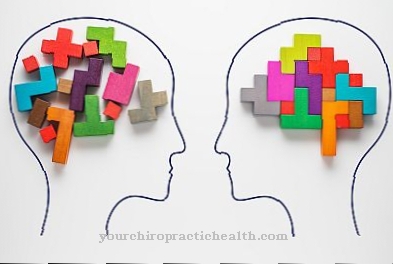The Asterixis is the symptom of metabolic brain damage. Liver or kidney damage can also damage the brain, for example. Asterixis patients suffer from gross tremor of the hands due to such damage.
What is asterixis?

© logo3in1 - stock.adobe.com
Involuntary tremors are also called tremors in medicine. The trembling movements are a sequence of rhythmically repeated contractions of antagonistic muscle groups. Everyone has a physiological tremor that is barely visible. As soon as it is clearly visible, the tremor is a pathological phenomenon that can be associated with various diseases. The tremor marks the asterixis.
This disease is classified under the coordination disorders and is characterized by rough trembling movements of the hands. Usually the asterixis develops as a result of toxic or metabolic brain damage. Flutter tremors are also mentioned in connection with liver damage.
Actually, the asterixis is not a tremor in the narrower sense, since it is not based on the contraction of antagonistic muscles, but on a short-term loss of tone of the muscles. This loss of tone triggers a reflex correction that manifests itself as tremors. The Asterixis was first described in 1949. Adams and Foley are considered to be the first to describe it. An asterixis of the legs interferes with standing and walking. Often falls as a result of this.
causes
Asterixis is a symptomatic movement disorder, which usually starts from brain damage. The damage results in a brief temporary inhibition of the extensor muscles in the forearm muscles, which causes the hands to flex. As soon as the hand has moved down, a reflex compensates for this posture with a stretching movement and tries to move the hand back to its starting position.
There is often talk of a causally negative myoclonus, which is followed by a reflex corrective movement. According to the previous case reports, the most common cause of flutter tremor appears to be metabolic encephalopathies. This is the term used to describe metabolic brain damage. For example, the asterixis can accompany hepatic encephalopathies.
It is also a characteristic symptom in acute liver failure or in the context of Wilson's disease. The primary cause is much less likely to be kidney failure or medication. Metabolic brain damage occurs because of the substances that are produced in metabolic diseases or that are left in the body. In this context, we can also speak of substances with a toxic effect.
Asterixis patients show symptoms as soon as they are asked to stretch out their hands and keep them straight with stretched fingers. The tremor looks gross. A sudden flexion in the wrist can be seen, which occurs rhythmically or arrhythmically and has a frequency of about four hearts. After the flexion, there is a reflex movement for correction.
When patients hold their arms at their sides, the movements act like flapping wings. In most cases the tremors are on both sides of the body. In individual cases, however, a one-sided expression is also conceivable. There is often symmetry with bilateral tremors. Basically, the asterixis itself is just the system of another disease. The symptoms accompanying the tremors depend on the primary cause.
In connection with kidney insufficiency, for example, accompanying symptoms such as back pain, proteinuria and discoloration of the urine are conceivable. With all organ damage, brain damage can, depending on the location, also be associated with accompanying symptoms that affect perception, motor skills or other body processes.
You can find your medication here
➔ Medicines to calm down and strengthen nervesDiseases with this symptom
- Hepatic encephalopathy
- Liver failure
- Wilson disease
Diagnosis & course
The neurologist usually recognizes an asterixis with a visual diagnosis. For closer assessment and observation, he will ask the patient to position himself in the room with his hands outstretched. If the gross tremor sets in, there is probably brain damage. Imaging of the brain can confirm this damage.
The medical history can be used to diagnose the primary cause of the symptom. If, for example, kidney or liver disease is discussed in the course of the patient interview, the diagnosis of asterixis can be considered confirmed. If no metabolic diseases have been diagnosed to date, extensive general examinations of the metabolic organs take place. The prognosis of the asterixis depends on the primary cause.
Complications
Asterixis, which occurs primarily as a result of metabolic or toxic brain damage or in kidney failure, can lead to various complications when it occurs and in the further course of the respective underlying disease. The symptom is primarily associated with severe malaise and restricted motor skills for the patient.
In addition, there may be severe pain in the arms and especially in the wrists, due to the constant tension and jerky flexion of the hands and fingers. In addition, the asterixis leads to numbness in the affected limbs and can therefore severely limit the affected person's everyday life. Early treatment by a doctor is therefore advisable, although the therapy options vary greatly from cause to cause.
Usually the asterixis itself does not lead to problems, but the underlying disease. This can range from a variety of muscle disorders such as tremors to kidney failure. In the latter case, the tremors that typically occur with asterixis is just one of many symptoms. If the asterixis occurs as a result of a primary writing tremor, inflammation in the affected limbs is often another complication. Treatment with propranolol and primidone often promises improvement here. If the cause of the asterixis is not treated, permanent nerve damage can occur.
When should you go to the doctor?
Asterixis syndrome is characterized by trembling of the hands. It is also known as "tremor" or "flapping tremor" or "flutter tremor". Typical for this type of hand trembling are rough shaking movements of the hands. They are easily caused by trying to put their hands, including fingers, straight ahead without a clearly visible tremor. When the arms are extended to the side, the tremor resembles the flapping of the wings. The asterixis usually occurs on both sides, rarely on one side.
The asterixis is an expression of a metabolic impairment of the brain that has occurred due to liver or kidney damage. The damaged brain can no longer adequately control the muscles that govern the forearm. For the family doctor, the asterixis primarily indicates liver damage. He must also consider a possible kidney impairment as well as the genetic copper storage disease Wilson's disease or a drug side effect as a cause of the asterixis. In the case of an asterixis, the family doctor will refer his patient to specialist colleagues for further diagnosis, for example to an internist, gastroenterologist or nephrologist.
In the treatment of the disease on which an asterixis is based, a possible alcohol abuse should also be discussed. In the case of alcohol abuse, a withdrawal treatment should be sought in addition to treating the underlying disease with the patient.
Doctors & therapists in your area
Treatment & Therapy
After the diagnosis of asterixis, the treatment steps depend primarily on the primary disease in which the brain damage occurred. In the case of renal insufficiency, in addition to dialysis, a transplant, for example, can be discussed. The symptom of asterixis cannot be treated causally in the narrower sense. The brain damage has already occurred. As a rule, brain tissue cannot regenerate completely.
This does not fix the actual cause of the asterixis. However, the appearance can be improved by supportive treatment so that it no longer interferes with the life of the person affected. With this goal in mind, patients take part in physiotherapy training sessions. After brain damage from strokes, physiotherapy could, for example, shift the function of the damaged brain areas to intact brain areas in individual cases.
Thereafter, the patients were largely asymptomatic. The asterixis can theoretically be brought to dissolve despite irreversible damage to the brain. If the tremors do not improve through physiotherapy, the patients at least learn how to deal with them with the help of occupational or physiotherapy.
Outlook & forecast
Based on the underlying disease, the prognosis for an asterixis is very different. In principle, however, a spontaneous healing of the disease cannot be assumed. And even if the cause can be successfully corrected, the symptoms can still persist.
If the cause lies in brain damage, it is not curable according to current medical knowledge. Since the damaged brain tissue can no longer regenerate, the so-called flutter tremor cannot be reversed by medical treatment in this case.
If the cause is acute liver failure or renal insufficiency, immediate treatment may improve symptoms. Both acute liver and kidney failure are life threatening. If, for example, dialysis is carried out, there may already be an improvement. If you have severe kidney failure, a successful kidney transplant can help cure the asterixis.
Accompanying therapeutic measures also help the patient to deal better with the typical symptoms in everyday life. In addition to occupational therapy and physiotherapy to learn about changed movement sequences, behavioral therapy also plays a role, in which one learns how new strategies for coping with certain tasks can be integrated into everyday life. As a rule, it is then also possible for those affected to be able to return to a regular job.
You can find your medication here
➔ Medicines to calm down and strengthen nervesprevention
Asterixis can only be prevented to the extent that metabolic brain damage or diseases such as liver cirrhosis can be prevented. For example, the conscientious handling of toxic substances can largely be described as a preventive measure.
You can do that yourself
Asterixis or flutter tremor is always caused by metabolic damage to certain areas of the brain or by a stroke. In the case of metabolic damage to the brain cells, the treatment of the diseased metabolic organs such as the liver or kidneys is paramount in order to stop the course of the disease as far as possible.
Everyday and self-help is always aimed at alleviating the symptoms of asterixis. Since certain areas of the brain are irreversibly damaged when the symptoms occur, other areas of the brain can be made to take over the tasks and functions through targeted exercise training. It is advisable to work with an experienced physiotherapist to design an exercise program that can also be carried out at home as a self-help. The procedure is comparable to physiotherapy programs, which are usually developed after a stroke to train other areas of the brain to take over certain functions.
The symptoms can also be temporarily relieved by using active relaxation exercises such as autogenic training, yoga and meditation. Both forms of therapy, physiotherapy training and active relaxation, can be carried out as self-help. The ultimate goal is that those affected can lead a largely normal and self-determined life, provided that the underlying disease that triggered the symptoms of the asterixis is treatable and also treated.
























.jpg)



